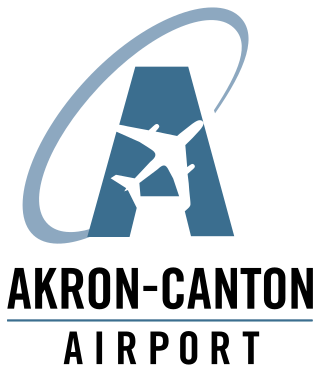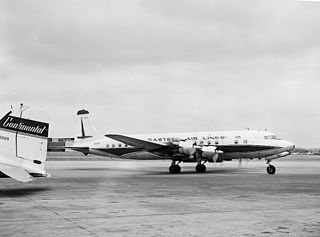
American Airlines Flight 191 was a regularly scheduled domestic passenger flight in the United States from O'Hare International Airport in Chicago, Illinois, to Los Angeles International Airport in California. On the afternoon of May 25, 1979, the McDonnell Douglas DC-10-10 operating this flight was taking off from runway 32R at O'Hare when its left engine detached from the wing, causing a loss of control, and the aircraft crashed less than one mile (1.6 km) from the end of the runway. All 258 passengers and 13 crew on board were killed, along with two people on the ground. With 273 fatalities, it is the deadliest aviation accident to have occurred in the United States.

The McDonnell Douglas MD-80 is a series of five-abreast single-aisle airliners developed by McDonnell Douglas. It was produced by the developer company until August 1997 and then by Boeing Commercial Airplanes. The MD-80 was the second generation of the DC-9 family, originally designated as the DC-9-80 and later stylized as the DC-9 Super 80 . Stretched, enlarged wing and powered by higher bypass Pratt & Whitney JT8D-200 engines, the aircraft program was launched in October 1977. The MD-80 made its first flight on October 18, 1979, and was certified on August 25, 1980. The first airliner was delivered to launch customer Swissair on September 13, 1980, which introduced it into service on October 10, 1980.

Delta Air Lines Flight 1141 was a scheduled domestic passenger flight between Dallas/Fort Worth, Texas and Salt Lake City, Utah. On August 31, 1988, the flight, using a Boeing 727-200 series aircraft, crashed during takeoff, resulting in 14 deaths and 76 injuries of the 108 on board.

On 25 July 2000, Air France Flight 4590, a Concorde passenger jet on an international charter flight from Paris to New York, crashed shortly after takeoff, killing all 109 people on board and four on the ground. It was the only fatal Concorde accident during its 27-year operational history.

United Airlines Flight 232 was a regularly scheduled United Airlines flight from Stapleton International Airport in Denver to O'Hare International Airport in Chicago, continuing to Philadelphia International Airport. On July 19, 1989, the DC-10 serving the flight crash-landed at Sioux Gateway Airport in Sioux City, Iowa, after suffering a catastrophic failure of its tail-mounted engine due to an unnoticed manufacturing defect in the engine's fan disk, which resulted in the loss of many flight controls. Of the 296 passengers and crew on board, 112 died during the accident, while 184 people survived. At the time it was the deadliest single-aircraft accident in the history of United Airlines.

Akron–Canton Airport is a commercial airport in the city of Green, in southern Summit County, Ohio. The airport is located about 14 miles (23 km) southeast of Akron and 10 miles (16 km) northwest of Canton. It is jointly operated by Summit County and Stark County. The airport is a "reliever" airport for Northeast Ohio and markets itself as "A better way to go", emphasizing the ease of travel in comparison to Cleveland Hopkins International Airport. Just under 90% of its traffic is general aviation. It is included in the Federal Aviation Administration (FAA) National Plan of Integrated Airport Systems for 2019–2023, in which it is categorized as a small-hub primary commercial service facility.

On August 16, 1987 a McDonnell Douglas MD-82, operating as Northwest Airlines Flight 255, crashed shortly after takeoff from Detroit Metropolitan Airport, about 8:46 pm EDT, resulting in the deaths of all six crew members and 148 of the 149 passengers, along with two people on the ground. The sole survivor was a 4-year-old girl who sustained serious injuries. It was the second-deadliest aviation accident at the time in the United States. It is also the deadliest aviation accident to have a sole survivor.

Pan Am Flight 214 was a scheduled flight of Pan American World Airways from Isla Verde International Airport in San Juan, Puerto Rico, to Friendship Airport near Baltimore, and then to Philadelphia International Airport. On December 8, 1963, the Boeing 707-121 serving the flight crashed near Elkton, Maryland, while flying from Baltimore to Philadelphia, after being hit by lightning. All 81 occupants of the plane were killed. The crash was Pan Am's first fatal accident with the 707, which it had introduced to its fleet five years earlier.

Eastern Air Lines Flight 512 was a scheduled domestic passenger flight from Charlotte, North Carolina, to New York City that crashed on November 30, 1962, killing 25 of the 51 people on board. The aircraft, a Douglas DC-7B operated by Eastern Air Lines, crashed at Idlewild Airport in heavy fog while attempting to perform a go-around. One of the plane's wings struck the ground and the plane crashed into soft sand in a marsh about 200 yards (180 m) from the runway, where it burst into flames. Emergency crews responded, but rescuers were delayed by the thick fog and the soft terrain. An investigation launched after the crash found that the probable cause of the accident was that the pilots had made critical mistakes during the go-around that prevented the aircraft from gaining altitude.

Northeast Airlines Flight 823 was a scheduled flight from New York City's LaGuardia Airport to Miami International Airport, Florida, which crashed shortly after takeoff on February 1, 1957. The aircraft operating the service was a Douglas DC-6 four-engined propeller airliner, registration N34954, which entered service in 1955.

Continental Airlines Flight 1713 was a commercial airline flight that crashed while taking off in a snowstorm from Stapleton International Airport in Denver, Colorado, on November 15, 1987. The Douglas DC-9 airliner, operated by Continental Airlines, was making a scheduled flight to Boise, Idaho. Twenty-five passengers and three crew members died in the crash.

United Airlines Flight 859 was a Douglas DC-8, registration N8040U, on a scheduled passenger flight that crashed on landing at Stapleton International Airport in Denver, Colorado after departing from Omaha, Nebraska's Eppley Airfield on July 11, 1961. Eighteen people were killed, and 84 were injured.

Northwest Orient Airlines Flight 2 was a Boeing 377 Stratocruiser aircraft that was ditched into Puget Sound, just off Maury Island at the Point Robinson Light, shortly after takeoff from Seattle-Tacoma International Airport (Sea-Tac) on the morning of Monday, April 2, 1956.

Pan Am Flight 6 was a round-the-world airline flight that ditched in the Pacific Ocean on October 16, 1956, after two of its four engines failed. Flight 6 left Philadelphia on October 12 as a DC-6B and flew eastward to Europe and Asia on a multi-stop trip. On the evening of October 15 the flight left Honolulu on a Boeing 377 Stratocruiser Clipper named Sovereign Of The Skies. The accident was the basis for the 1958 film Crash Landing.

Alliance Air Flight 7412 was a scheduled Indian domestic passenger flight from Calcutta to Delhi, operated by Indian regional airliner Alliance Air. On 17 July 2000, while on approach to its first stopover in Patna, the Boeing 737-2A8 operating the route nose-dived and crashed into a residential area in Patna, killing 60 people including 5 on the ground.

United Air Lines Flight 608 was a Douglas DC-6 airliner, registration NC37510, on a scheduled passenger flight from Los Angeles to Chicago when it crashed at 12:29 pm on October 24, 1947 about 1.5 miles (2.4 km) southeast of Bryce Canyon Airport, Utah, United States. None of the five crew members and 47 passengers on board survived. It was the first crash of a DC-6, and at the time, it was the second-deadliest air crash in the United States, surpassed by Eastern Air Lines Flight 605 by only one fatality.

Belavia Flight 1834 was a scheduled international passenger flight from Yerevan, Armenia, to Minsk, Belarus, operated by Belavia. On the morning of February 14, 2008, the Bombardier Canadair Regional Jet carrying 18 passengers and three crew crashed and burst into flames shortly after take off from Zvartnots International Airport near Yerevan, the capital of Armenia.

Imperial Airlines Flight 201/8 was a charter flight by the United States Army to transport new recruits to Columbia, South Carolina for training. On November 8, 1961, the aircraft crashed as it attempted to land at Byrd Field, near Richmond, Virginia. This was the second deadliest accident in American history for a single civilian aircraft.

American Airlines Flight 910, a four-engine Douglas DC-6 propliner, collided in mid-air with a single engine Temco Swift on final approach to Dallas Love Field on June 28, 1952, over Dallas, Texas. The DC-6 was carrying 55 passengers and 5 crew members from San Francisco, California. The DC-6 landed with no injuries to any of its 60 occupants, while both occupants of the two-person Swift died when their aircraft impacted the ground.



















